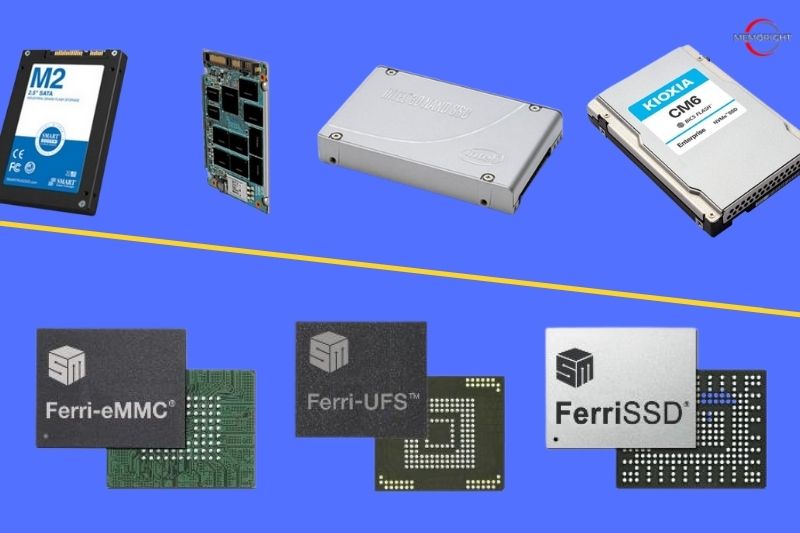Do laptops with eMMC storage perform better than those with SSDs? Get all the information you need about these two storage technologies from this eMMC vs SSD explained article.
Overview of eMMC and SSD
What Is eMMC?
The Embedded Multi-Media Card, or eMMC, is an embedded, non-volatile memory system that has both NAND flash memory and a flash memory controller integrated on a single silicon die and is fused onto the host device’s motherboard (where the “embedded” part of the name comes from).
MMC, from which eMMC was derived, was the predecessor to the modern Secure Digital (SD) card, and eMMC shares much in common with the SD card format. SD cards have overtaken MMC as the favored removable flash memory card and SD slots are predominantly featured on devices today over MMC slots.
You’ll normally find eMMCs within devices such as Chromebooks, some budget laptops, tablets, and mobile devices due to their smaller size, significantly lower cost per gigabyte, and lower power consumption versus SSDs.
What Is SSD?
A Solid-State Drive, or SSD, is a non-volatile, persistent data storage system on solid-state, NAND flash memory. They are the successor to the hard disk drive (HDD) and perform many of the same functions, but much faster. Additionally, SSDs have no moving parts and are less prone to breaking. Learn more about HDD vs SSD here.
Unlike eMMC, SSDs are connected to the motherboard via SATA (Serial ATA) 3, mSATA, SATA Express, or PCIe interface and they can be easily removed and upgraded. SSDs come in various form factors and connection protocols to meet the needs of users. They are commonly found in laptops, desktops, and tablets.
Even though the price of SSD is decreasing as time goes on, the cost of its every unit of storage (up to 2018) still surpasses hard drives. It is predicted that its superiority in cost will keep in 10 years.
In terms of NAND gates, unlike eMMC, SSD has several NAND flash chips up to 15 or 20 chips on a single board.
Regarding these NAND chips (ICs), each one has the same flash memory as eMMC. With these ICs, an SSD will perform very fast, even faster than eMMC.
Also, the interface with which SSD is attached to a circuit board allows for its removal and reconnection. This makes it upgradeable, unlike the eMMC.
eMMC vs SSD Compared
1. Storage Size Range
SSD and eMMC storage devices differ in their capacity specifications. The eMMC drives are often used as temporary storage on portable devices such as budget phones, laptops, tablets, and digital cameras. They’ve considerably smaller storage capacities in the range of either 32GB – 64GB, or 128GB – 256GB.
On the other hand, SSD drives are used as permanent media on devices with larger storage capacity requirements. The storage capacities range from 128GB to terabytes. These drives are suitable for high-performance electronics such as gaming PC and tablets, among others.
2. Data Transfer Speed
Speed difference between 64GB eMMC and SSD 128GB in the Surface Go.
The current standard for eMMC storage is v5.1A, which can effectively deliver transfer speeds of up to about 400MB/s. That’s not necessarily slow, and SATA SSDs will top out around the same.
However, it’s not just the overall transfer rate that determines how a device’s performance will be affected. eMMC storage usually operates with fewer memory gates than an SSD, meaning it can still deliver at the same speed, just not at the same volume.
SSDs and eMMC drives both have different data transmission speeds. For example, eMMC drives have a top transfer speed of up to 600 MB/s. As such, they are best for the storage and retrieval of small file systems.
| Interface | Version | Max. Transfer
speed (MB/s) |
Max. Write
speed (MB/s) |
| Embedded
MultiMediaCard (eMMC) |
4.5 | 200 | 60 |
| 5.0 | 400 | 90 | |
| 5.1 | 600 | 125 |
In terms, SSD drives have impressive top transfer speeds averaging 3,500 MB/s and top write speeds of up to 3,300 MB/s. It’s worth mentioning that data transmission speeds for SSD drives vary depending on the protocol version. For instance, SATA2 has a maximum speed of 200MB/s, SATA3 has a maximum speed of 600MB/s, while PCle and M2 have top speeds of more than 1GB/s.
| Interface | SSD protocol version | Max. Read Speed (MB/s) | Max. Write Speed (MB/s) |
| SSD | SATA3 | 550 | 500 |
| NVMe | 5000 | 3000 |
3. Expansion or Replacement Options
In terms, eMMC is very difficult to upgrade, if at all possible. More specifically, upgrading eMMC storage requires special technical skills in electronics soldering and desoldering.
Conversely, upgrading an SSD storage is less complicated. Even at that, it also requires some level of understanding of computer hardware maintenance.
4. The Service Life/ Lifespan of the Drive
eMMCs and SSDs have an average service life of 5 years. Modules with larger capacities have a longer lifespan than those with smaller storage capacity. Meaning, that a 64GB eMMC will last much longer than a 32GB eMMC. The same is true for the 128GB and 256GB modules. Of course, the lifespan is also affected by the drive’s version and frequency of use i.e., the more an eMMC drive is used, the shorter its lifespan gets. The converse is also true.
SSDs have an estimated lifespan of 10 years. Be that as it may, the average service life of an SSD may be shorter or slightly longer depending on usage and a host of other factors.
The best way to explain the differences in the service life of both drives is to compare their storage mediums and program erasure time (PE).
As it is currently, eMMC drives utilize the Triple Level Cell Flash (TLC) memory that stores up to 3 bits of data per memory cell.
Though they pack more data per cell, TLC eMMCs have a characteristically short lifespan. Moreover, the high program erasure time of about 1,000 times also contributes to the degradation of eMMC’s NAND flash memory cells, thus further eating into their service life.
Unlike eMMCs, SSDs have no unified storage medium. Instead, the typing of SSDs is based on the number of memory cells available for writing data. The types include Single Level Cell (SLC) SSDs, Multi-Level Cell (MLC) SSDs, and Triple Level Cell (TLC) SSDs. The 3 type of storage also have different programs erasure cycles (PE) i.e. TLC (1,000 PE) < MLC (1,000 – 3,000 PE) < SLC (10,000). All the 3 types of SSDs differ in terms of speed, reliability, and of course, lifespan, with TLC SSDs being the least durable while SLC SSDs are the most durable.
The differences in durability notwithstanding, SSDs have a much longer service life when compared to eMMC drives.
5. Drive Recyclability
The eMMC drives can be migrated and used on another device when the original gadget is damaged or is simply no longer usable. However, considering the low price tag associated with most eMMC electronics, recycling these drives is highly unlikely because it’s not sensible in economic terms.
On the contrary, SSD drives are often reused. The architecture of these drives (the high-quality hardware, super-fast SATA or PCle interface, firmware, and multiple NAND flash memory chips) makes for their superior performance, longevity, and high price tag. Therefore, it only makes sense that SSDs be reused on other devices whenever the original device is damaged beyond repair.
6. Price
SSDs usually have a higher price tag compared to embedded MultiMediaCard. Typically, the average charge per gigabyte ranges between $0.20 and $0.25 for SSDs and, of course, much lower for eMMC drives. If you do the math, the price of an average capacity SSD comes to approximately four times more than the price of a traditional hard disk drive.
Even cheaper are eMMC drives, considering their small storage capacities and low-performance speeds. Here are price comparison tables for eMMC and SSD drives.
Which One Should I Buy?
When it comes to choosing between the two flash drives, your decision should be informed by, among other factors, performance expectations, durability, capacity, and budget. Even though eMMC drives are often used in portable consumer electronics such as mobile phones, tablets, and some laptops, they are slowly being replaced by Universal Flash Storage (UFS) drives that are comparatively faster at data transmission.
Among SSDs, NVMe or PCIe are great picks for anyone looking for an SSD that guarantees speedy data transmission, reliability, and durability.
When Need to Replace eMMC with SSD?
Despite the superior performance of the SSD, you may still hesitate to buy one. You may ask: Do I really need to spend so much money to buy SSD for my laptop?
Imagine that you go a long way to download your favorite game, but you have to wait for more than several minutes to run it because your laptop uses other types of internal storage devices instead of SSD. At last, your laptop gets stuck several times and you lose this game as well. On the contrary, a laptop with SSD can help you enjoy better performance and delivers better read and write speed.
Moreover, if the hard drive capacity is small for your laptop, you need to remove some applications or delete some files because your hard drive is nearly full. But a laptop with SSD enjoys larger storage space and allows you to save more loved and significant files.
Although the SSD is smaller than HDD, it is still larger than the eMMC and it is enough for you to install Windows 10, Office-related software, and even Photoshop. But you already know that new files and data will generate at the time you run your laptop. It is necessary to know that once your SSD has been used more than 75%, its performance will also be affected.
So if you want to enjoy better performance of your computer, you can choose to try eMMC upgrade. Thus, you can choose to upgrade eMMC with SSD.
FAQs
Is eMMC better than an SSD?
Each of the drives is ideally suited for a particular purpose. For instance, while SSDs deliver much faster data transmission speeds and are ideal for the internal storage of large files, eMMCs are equally exceptional at handling smaller files.
Can you replace eMMC with an SSD?
If by “replace” you mean taking the place of, then that’s not possible. That’s because eMMCs are soldered on the motherboard while SSDs are attached to the motherboard via an M.2 slot. Clearly, neither can take the place of the other.
However, if “replace” to you means to upgrade, then yes, that’s possible. You only need to ensure your laptop is compatible with SSD drives.
Is 128GB eMMC enough for a laptop?
Most of the laptops you see that use eMMC storage will only have around 64GB or 128GB storage space. This kind of laptop is fine if you’re going to take advantage of cloud storage instead (like Google Drive).
Conclusion
If you’re trying to work out which would be best for your laptop, then it’s undoubtedly going to be an SSD. They’re much faster than the other options out there, and although they are more expensive, it’s likely going to be worth the price.
For those trying to save cash, then an eMMC might be the only choice that you have. In terms of an eMMC vs SSD, then they can’t really compare on any level aside from their low cost. If this is the case, you’re just going to need to get used to using online storage options in tandem with your eMMC storage.
We hope this guide has helped you in deciding whether to buy a device with eMMC storage vs. SSD.






